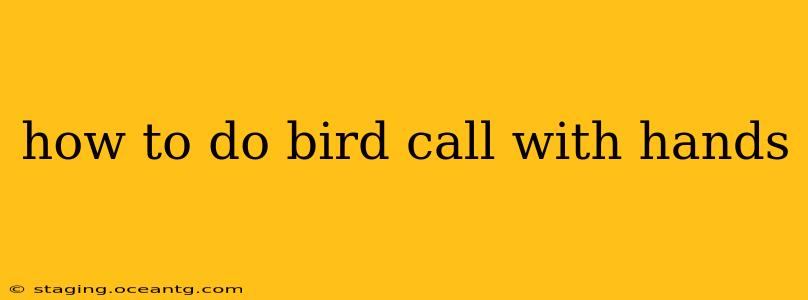How to Make Bird Calls with Your Hands: A Comprehensive Guide
Many of us have tried to mimic bird songs, often with hilarious results. While perfectly replicating the intricate melodies of birdsong requires dedicated practice and perhaps even some natural talent, creating basic bird calls with your hands is surprisingly simple and fun. This guide will show you how, exploring different techniques and sounds you can achieve.
What kind of bird calls can you make with your hands?
This is a common question, and the answer is: it depends on your technique! You won't be able to perfectly replicate a Nightingale's trill, but you can create sounds reminiscent of various birds. Generally, you'll be able to create sounds resembling whistles, chirps, and short, sharp calls commonly associated with smaller birds. Think of simple, repetitive sounds rather than complex melodies.
How do you make a bird whistle with your hands?
This is perhaps the most common hand-bird-call technique. You'll need to form a shape that directs your breath effectively. There are several variations:
-
The "O" shape: Form a circle with your thumb and index finger, placing your lips around the opening. Blow gently, experimenting with the size of the opening and the pressure of your breath to vary the pitch and tone. This method can create a high-pitched whistle, similar to the call of small songbirds.
-
The cupped hands method: Cup your hands together, forming a small, enclosed space. Blow gently into the opening, again adjusting your breath control to alter the sound. This method can produce a slightly lower-pitched whistle or a more resonant sound.
-
The "pea-shooter" method: While not strictly a whistle, you can create a short, sharp chirp by forming a small opening with your hands and blowing sharply. Experiment with different hand positions to vary the pitch and timbre.
What are some tips for improving my hand bird calls?
Practice makes perfect! The more you experiment, the better you'll become at controlling the pitch, volume, and tone of your calls. Here are some additional tips:
- Experiment with different hand positions: Slight adjustments in your hand shape can dramatically alter the sound.
- Control your breath: A steady, controlled breath is essential for producing clear, consistent sounds.
- Listen to real bird calls: Pay attention to the rhythms and patterns of bird songs to get a better sense of how to mimic them with your hands.
- Practice in front of a mirror: Observing your hand position and breath control can help you refine your technique.
Are there other ways to make bird sounds with my hands besides whistling?
Yes, while whistling is the most common method, you can also experiment with creating other sounds. For example, you could try:
- Clicking your tongue: This can produce a series of short, rapid clicks that might resemble the call of some smaller birds.
- Using your fingers to tap against your mouth or cheek: This can create a range of percussive sounds, depending on the pressure and rhythm.
Remember, the goal is to have fun and be creative. Don't be discouraged if your initial attempts sound less than perfect – with practice, you'll be surprised at the sounds you can create!
Can I use my hands to mimic a specific bird's call?
While precise mimicry of a complex birdsong is difficult with just your hands, you can aim for a general impression. Listen carefully to the bird's call you're trying to imitate. Focus on its pitch, rhythm, and volume to guide your hand movements and breath control. For instance, a robin's cheerful chirping might be better suited to the "O" shape whistle than a deep-throated crow's caw.
This guide provides a starting point. Through experimentation and practice, you can develop your own unique style of hand bird calling!
